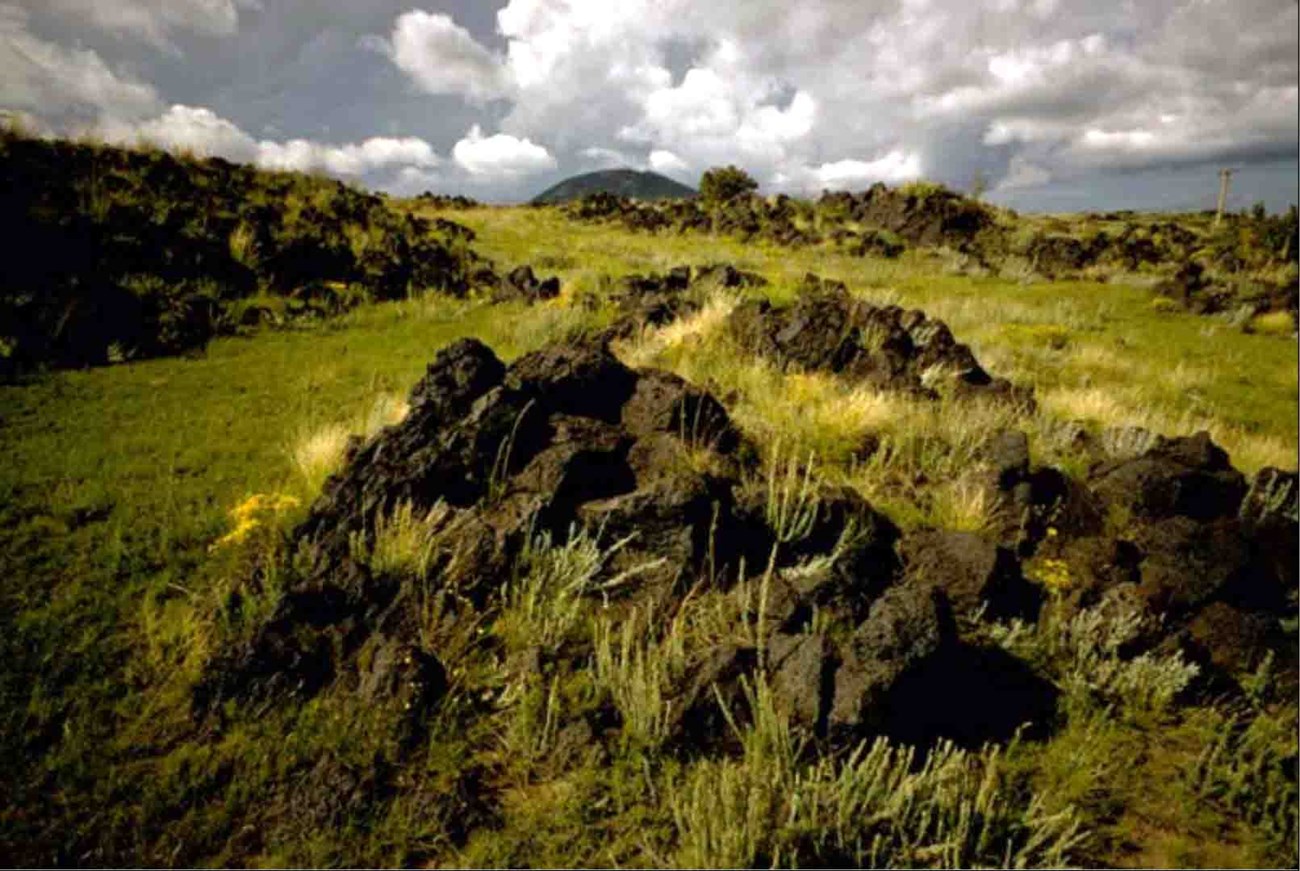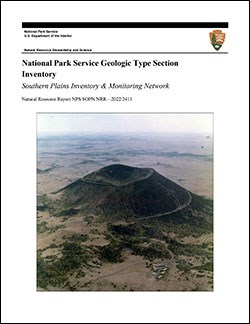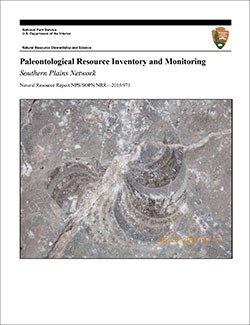
NPS photo.
Geology and Stratigraphy of the Southern Plains I&M Network Parks
The Southern Plains Inventory & Monitoring Network (SOPN) consists of 12 national park units in southeastern Colorado, northeastern New Mexico, western Kansas, Oklahoma, and north and central Texas. These units are Alibates Flint Quarries National Monument, Bent’s Old Fort National Historic Site, Capulin Volcano National Monument, Chickasaw National Recreation Area, Fort Larned National Historic Site, Fort Union National Monument, Lake Meredith National Recreation Area, Lyndon B. Johnson National Historical Park, Pecos National Historical Park, Sand Creek Massacre National Historic Site, Waco Mammoth National Monument, and Washita Battlefield National Historic Site. The parks that comprise the Southern Plains Network protect a combined 32,596 hectares (80,548 acres) of wilderness and vary in size from 43 hectares (107 acres) in Waco Mammoth to 18,201 hectares (44,978 acres) in Lake Meredith.
Geographically, the southern Great Plains is an immense sweep of country that reaches from south-central Texas to the northern border of Kansas and spreads out east of the Rocky Mountains. There is often a misconception of the Great Plains as a drab, flat, featureless area, when in fact the region encompasses a suite of diverse geologic landscapes that include canyons carved into solid rock by the waters of the Pecos River, the seemingly endless grainfields of Kansas, the precipitous peaks of the Sangre de Cristo Mountains, and the volcanic terranes of New Mexico.
Most of the park units of the Southern Plains Network occupy one of several sections of the Great Plains physiographic province such as the Central Texas Uplift (Lyndon B. Johnson, Waco Mammoth), High Plains (Alibates Flint Quarries, Lake Meredith, Sand Creek Massacre), Pecos Valley (Pecos), Raton (Capulin Volcano, Fort Union), Colorado Piedmont (Bent’s Old Fort), and Plains Border (Fort Larned). The Central Texas Uplift is a forested prominence at the southern end of the Great Plains. The High Plains is characterized by an expansive, nearly flat plateau that extends from the Texas Panhandle north to Nebraska and forms the central backbone of the Great Plains. The South Platte and Arkansas Rivers and their tributaries have dissected an area along the Rocky Mountain front that is called the Colorado Piedmont. The Pecos Valley section is a broad excavated valley of the Pecos River that stretches southward from the Sangre de Cristo Mountains in New Mexico into Texas. Green, crop-filled valleys with gently sloping valley walls and rounded stream divides trend eastward from the High Plains of western Kansas and characterize the Plains Border section (Trimble 1980). Situated between the Colorado Piedmont on the north and the Pecos Valley on the south are the volcanic vents, cinder cones, and lava fields that define the distinctive Raton section.
The mountainous sections of the southern Great Plains were formed long before the remaining areas were outlined by erosion. One of the oldest structural features is the Llano Uplift, which represents the crystalline core of a mountain belt produced during the Precambrian. Basement uplifts such as the Arbuckle and Amarillo were formed around the Pennsylvanian–Permian during the final collisional stages that resulted in the supercontinent Pangea. The Central Texas Uplift began as the continental interior was raised and the last Cretaceous inland sea retreated approximately 70 million to 65 million years ago. These regions stood well above the surrounding plains long before any sediments from the distant Rocky Mountains began to accumulate at their bases (Trimble 1980).
In southern Colorado and northern New Mexico, molten rock (magma) was emplaced into older Precambrian basement rocks and Paleozoic and Mesozoic sedimentary strata during the Oligocene (~29 million and 22 million years ago), leading to widespread volcanic eruptions. Another pulse of intermittent volcanism began about 9 million years ago during the Miocene, with eruptions as young as 37 thousand years ago associated with the Raton-Clayton volcanic field (Capulin Volcano) and Ocaté volcanic field (Fort Union). A thick sequence of basalt flows accumulated at Raton Mesa and Mesa de Maya between 8 million and 2 million years ago. The archetype cinder cone of Capulin Volcano was created by a violent eruption during the Pleistocene only 54,000 years ago (Trimble 1980; KellerLynn 2015a). Many of these volcanic masses were present before major downcutting by streams began, which provided huge quantities of sediment that were subsequently transported to the plains and deposited. Regional uplifts that occurred between 10 and 5 million years ago enhanced stream incision that sculpted the modern landscape of the Colorado Piedmont, Pecos Valley, and 13 Plains Border sections. Many of the individual landforms of the southern Great Plains that now attract the eye have been created by geologic processes during the last 2 million years (Trimble 1980).
A Brief Geologic History
A few examples of events and Network resources in each geologic time period are highlighted below, from youngest to oldest.
Battlefield.
Geology & Soils—Southern Plains Network Parks
Type Sections—Southern Plains Network

The geologic history above is excerpted from a report titled, "National Park Service geologic type section inventory: Southern Plains Inventory & Monitoring Network". Type sections are essential reference locations for the geoscientists who study geologic history and paleontology. A summary of the type sections in each park can be found at the links below.
-
Alibates Flint Quarries National Monument, Texas (contains one identified stratotype)
-
Bent’s Old Fort National Historic Site, Colorado (no designated stratotypes identified)
-
Capulin Volcano National Monument, New Mexico (contains one identified stratotype)
-
Chickasaw National Recreation Area, Oklahoma (no designated stratotypes identified)
-
Fort Larned National Historic Site, Kansas (no designated stratotypes identified)
-
Fort Union National Monument, New Mexico (no designated stratotypes identified)
-
Lake Meredith National Recreation Area, Texas (no designated stratotypes identified)
-
Lyndon B. Johnson National Historical Park, Texas (no designated stratotypes identified)
-
Pecos National Historical Park, New Mexico (no designated stratotypes identified)
-
Sand Creek Massacre National Historic Site, Colorado (no designated stratotypes identified)
-
Waco Mammoth National Monument, Texas (no designated stratotypes identified)
-
Washita Battlefield National Historic Site, Oklahoma (no designated stratotypes identified)
The full Network report is available in digital format from:
Please cite this publication as:
-
Henderson, T., V. L. Santucci, T. Connors, and J. S. Tweet. 2020. National Park Service geologic type section inventory: Rocky Mountain Inventory & Monitoring Network. Natural Resource Report NPS/ROMN/NRR—2020/2215. National Park Service, Fort Collins, Colorado.
NPS Stratotype Inventory
Fossil Resources—Southern Plains Network

Between 2002 and 2011, network-based paleontological resource inventories were completed for all the 32 I&M networks, and six of the earliest were completely updated between 2012 and 2016. The report linked below summarizes the paleontological resources of all park units in the Southern Plains Inventory & Monitoring Network (SOPN). The report provides geologic background and paleontological resource data for each park to support management operations, planning, and science-based decision making as required by NPS management policies and the Paleontological Resources Preservation Act (2009).
The full report is available in digital format from
Please cite this publication as:
-
Tweet JS, Santucci VL, Connors T. 2015. Paleontological resource inventory and monitoring: Southern Plains Network. Natural Resource Report. NPS/SOPN/NRR—2015/971. National Park Service. Fort Collins, Colorado.
Geodiversity Atlas pages—by Inventory & Monitoring Network
Arctic Network Index
Central Alaska Network Index
Chihuahuan Desert Network Index
Cumberland Piedmont Network Index
Eastern Rivers and Mountains Network Index
Great Lakes Network Index
Greater Yellowstone Network Index
Gulf Coast Network Index
Heartland Network Index
Klamath Network Index
Mediterranean Coast Network Index
Mid-Atlantic Network Index
Mojave Desert Network Index
National Capital Network Index
North Coast and Cascades Network Index
Northeast Coastal and Barrier Network Index
Northeast Temperate Network Index
Northern Colorado Plateau Network Index
Northern Great Plains Network Index
Pacific Islands Network Index
Rocky Mountain Network Index
San Francisco Bay Area Network Index
Sierra Nevada Network Index
Sonoran Desert Network Index
South Florida/Caribbean Network Index
Southeast Alaska Network Index
Southeast Coast Network Index
Southern Colorado Plateau Network Index
Southern Plains Network Index
Southwest Alaska Network Index
Upper Columbia Basin Network Index
Geodiversity Atlas pages—by State, U.S. Commonwealth, and Territories
Alabama | Alaska | Arizona | Arkansas | California | Colorado | Connecticut | District of Columbia | Delaware | Florida | Georgia | Hawaii | Idaho | Illinois | Indiana | Iowa | Kansas | Kentucky | Louisiana | Maine | Maryland | Massachusetts | Michigan | Minnesota | Mississippi | Missouri | Montana | Nebraska | Nevada | New Hampshire | New Jersey | New Mexico | New York | North Carolina | North Dakota | Ohio | Oklahoma | Oregon | Pennsylvania | Rhode Island | South Carolina | South Dakota | Tennessee | Texas | Utah | Vermont | Virginia | Washington | West Virginia | Wisconsin | Wyoming
U.S. Commonwealth and Territories
Region 2: South Atlantic-Gulf (Includes Puerto Rico and the U.S. Virgin Islands)
Region 3: Great Lakes
Region 4: Mississippi Basin
Region 5: Missouri Basin
Region 6: Arkansas-Rio Grande-Texas-Gulf
Region 7: Upper Colorado Basin
Region 8: Lower Colorado Basin
Region 9: Columbia-Pacific Northwest
Region 10: California-Great Basin
Region 11: Alaska
Region 12: Pacific Islands (American Samoa, Hawaii. Guam, Commonwealth of the Northern Mariana Islands)
Last updated: February 21, 2025
